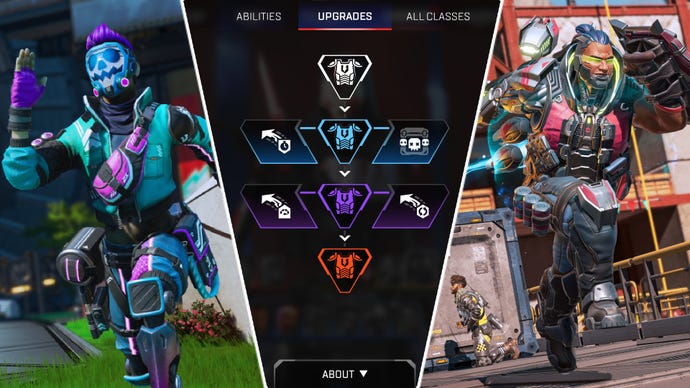Apex Legends Season 20: Breakout introduces one of “the biggest changes to date” – and you know what? It works
5 years in, Respawn is making some pretty fundamental changes to Apex Legends. They may be controversial, but at least they’re interesting.
“I can confidently say that in Breakout, we have the biggest change to how Legends will be played to date,” says John Larson, lead balance director for Apex Legends at a media summit where the studio is showing off its massive Season 20 overhaul. There’s an air of apprehension in the room; both media and devs know this is a big deal for one of the best free-to-play games out there – and a change that will set the path for the entire game’s ecosystem, moving forward.
To put it simply, this is a game-changer. Respawn has introduced a new system to in-game progression that is designed to eliminate early game RNG, and level the playing field for any team that drops into the map – whether they’re seasoned pros, or more casual players.
The long and short of it is this: each of the game’s 25 playable characters now has a 4-tier upgrade tree that you can work through as you play. As you ‘level up’, your shield will upgrade each time automatically (meaning you no longer find armor on the ground), and you’ll get new upgrades that can fundamentally alter how you play.
Wattson, for example, will have the option to use two modified pylons, or opt for one power pylon that’s a little more beefy. If you're a more quick-paced player, you want to take the option that lets you play around – and not the one that locks you into the stereotypical Wattson that sticks around in buildings, controlling one zone for a longer period of time. Lifeline gets a self-revive – something that even the devs are going to keep an eye on in the early days, since they know it has the ability to be ‘a bit much’.
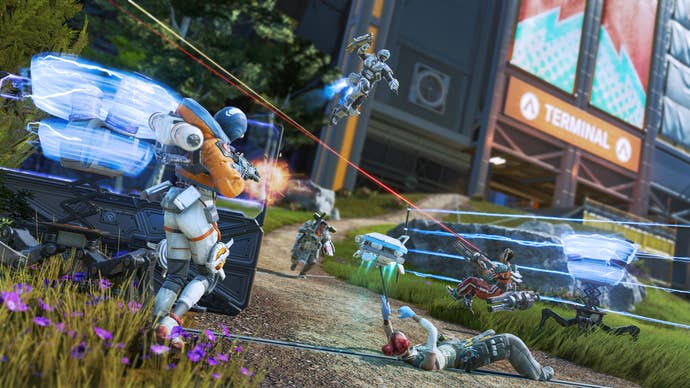
If you’re playing Gibby, do you want a protective bubble that lasts longer, or a smaller bubble with a shorter cooldown? It feels like the vast majority of the upgrades can be sorted into two categories: do you want to tank or be more mobile? But since each character now has the choice – and typically the game is played in teams of two or three – the Apex degs want you to experiment.
“I’ve been waking up in a cold sweat thinking about if I’ve missed an interaction – because there are so many ways legends can interact with each other, with all these varied upgrade paths – that maybe we have,” laughs Larson when I talk to him about the changes. “In development, you don’t always catch everything. But I think it’ll be really fresh, it’s a big change and there’s a lot for people to experiment with and find out.”
You level up by doing your standard battle royale tasks; inflicting damage, scouting, discovering items, pinging enemy teams, finding caches on the map that serve EVO (read: experience) to you and your team. Certain actions will grant the entire squad EVO points, whereas others (knocking, eliminating, damaging) will add EVO to your personal bank. But Respawn is keen for even non-combat specialists to reap the rewards of goal-based play.
“You’ll find that with support characters, for example, a lot of upgrades will help you reset from fights,” Larson continues, demoing an Octane that can place two pads down, rather than just one. “[Breakout’s level system] allows you more flexible ways to support your team other than just swapping weapons or armor.”
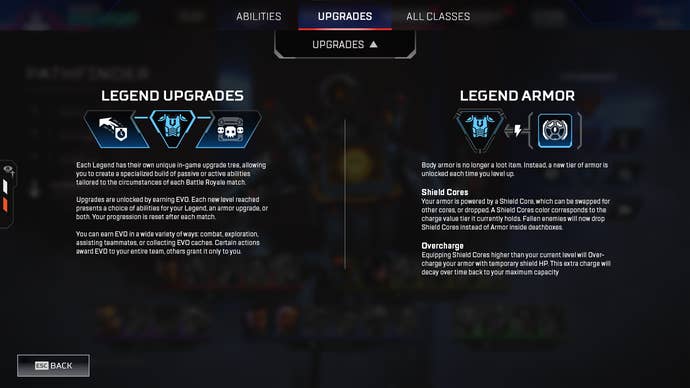
Speaking of armor, that’s another huge part of this update. Armor is no longer an item in the loot pool; you can’t improve your armour by simply finding it on the floor or in a loot bin – if you want more capacity for armour, you need to play for longer, basically.
“There’s an RNG element to whether you find a shield,” says Josh Mohan, lead gameplay designer for Apex Legends. “We found this, and a lot of our players did , too.” It’s true: you never knew, in the opening moments of a game in Apex Legends, if you’d be wandering around and about to get into a gunfight with some people already kitted out in higher-level, purple armour. That, for most players, would be the end of the game – shut off and shut down before you even had a chance to start looting for the weapons you want.
“By pairing Shield capacity to game progress, we feel like we’ve smoothed the whole battle royale system out a lot,” continues Mohan. “As a player, it means you can see your enemy and decide whether or not to engage, even early in the game. You can estimate your opponents’ strength a bit better this way, and we’ve found it really helps out in the encounter.”
In actually playing the game, I think he’s right; the dice rolls of the first few minutes have been removed, and whether or not you live, die, or flee an encounter comes down more to whether or not you know the game and believe in your skill, rather than whether you were lucky enough to find a purple armor pickup wherever you chose to land.
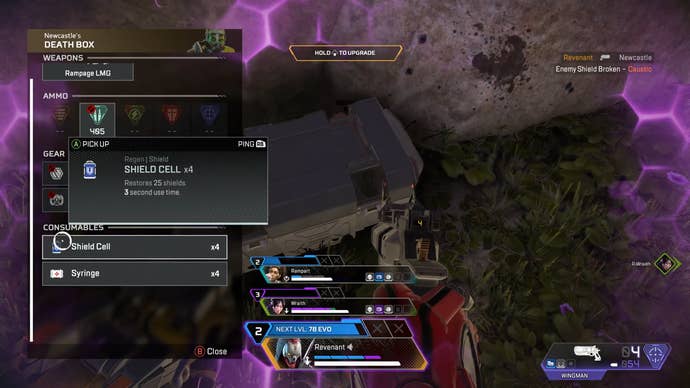
This same simplification process has been applied to the crafting system, too. Before Season 20, a lot of action in Apex Legends started to revolve around teams camping on crafting benches – waiting for the machines to spit out whatever upgrade they’d punched into the command console. It was counter to the ‘loot, fight, rotate’ rhythm a traversal-forward team like Respawn has been perfecting for the last 60+ months.
So, rather than crafting weapons and attachments, you will mainly craft consumables. Materials are gone from the game, and all crafters are single-use only: everyone can use it once, and move on. Respawn has also sped up interaction with the crafters; there’s no cook time, and the UI has been simplified, too. This means you can craft in dicier situations, and you don’t have to sit around and wait for it to cook like you used to have to.
“We took a hard look at all the different systems in our game, and we decided that having too many economies is too hard to manage in an FPS game,” continues Mohan. “We don’t want an XP system, an armor system, and a crafting system – that’s too much ecosystem work to do [for the average player].”
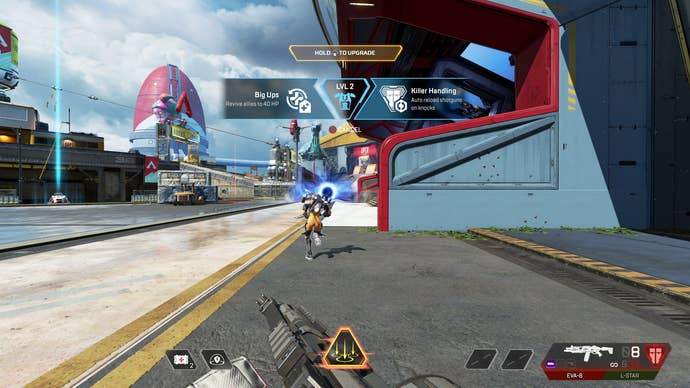
As you’d expect, this is going to have huge repercussions for the meta. “Rather than in previous systems where you could trade armour and level up with each other, your level is tied to you, and you alone,” explains Larson. “So there will always be variety in a team.” Does that mean you try to pick off the weakest member first, or go for the juggernaut that’s carrying them to break a team’s formation and tilt the hangers-on? Does it mean you’re going to choose not to engage in a melee until you’re one level higher – with a better armour rank and maybe another cooldown bonus on your Legend?
All these questions make Season 20 of Apex Legends a properly fresh experience – and the most different it’s felt season-to-season… well, since launch. It also means that Respawn has a better handle on the meta; with each hero having a selection of upgrades, the studio has more dials it can twiddle in the backend, meaning that if one Legend starts to dominate in ranked in an unfair way (remember the Caustic meta? Eesh), Respawn has a wider suite of tools to boost or nerf characters that won’t intrinsically affect who they are.
Perhaps this means Resapwn can give a quicker cooldown (or a better final upgrade) to a character that’s squishy and under-represented, or alter a particularly nasty final upgrade to something a bit more sedate. Simply, as Larson puts it, “[this new system] allows us to more rapidly respond to changes in the meta.”
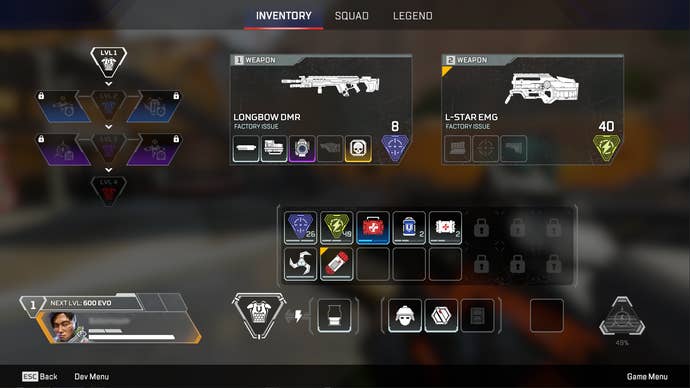
These changes will, no doubt, be controversial. They were controversial within Respawn when they were first floated – but the team eventually came around to the ideas. Will Season 20 be the final expression of this experimental system? Not by a long way – Larson concedes that Respawn will be “experimenting alongside the audience”, but in giving players more opportunity to enjoy “micro-successes” and streamline the now-classic Apex Legends gameplay loop, Season 20 is the biggest change we’ve seen to the battle royale since launch. I think it’s a brave move, and one that will be met with resistance from parts of the community. But damn, if this isn’t a brave way of injecting some much-needed life into a game.
Apex Legends, Season 20: Breakout, launches on February 13, 2024. If you need more FPS titles to check out, you can hit up our list of best FPS games in 2024.
Note: EA provided travel and accommodation for a media summit to cover Apex Legends Season 20: Breakout.
